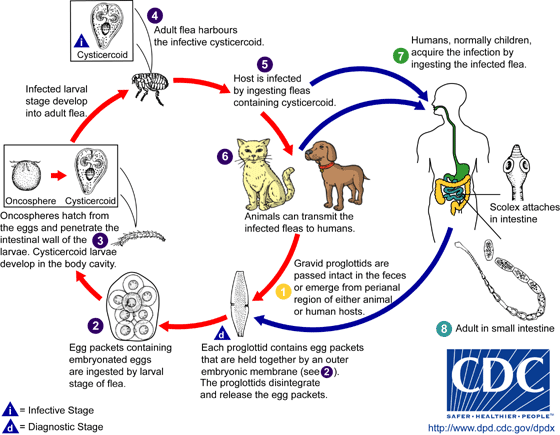Dipylidium caninum, also called the cucumber tapeworm or the double-pore tapeworm, is a cyclophyllid cestode that infects organisms afflicted with fleas, including canids, felids, and pet-owners, especially children. Adult worms are about 18 inches long. Eggs (or "egg clusters" or "egg balls") are passed in the host's feces and ingested by fleas, which are in turn ingested by another mammal after the tapeworm larvae partially develop. Examples of fleas that can spread D. caninum include: Ctenocephalides canis and Ctenocephalides felis.
As in all members of family Dipylidiidae, proglottids of the adult have genital pores on both sides (hence the name double-pore tapeworm). Each side has a set of male and female reproductive organs. The scolex has a rostellum with four rows of hooks, along with the four suckers that all cyclophyllid cestodes have. In cats, sometimes proglottids are visible hanging out of a cat's anus.
Inside fleas, eggs hatch and form oncosphere larvae that move through the wall of the flea intestine into the body cavity where they become cysticercoid larvae, which are infective to mammal hosts.
In children, infection causes diarrhea and restlessness. As with most tapeworm infections, the drugs of choice are niclosamide or praziquantel. The best way to prevent human infection is to treat infected animals and to kill fleas.
Although, D. Caninum is usually transferred via a flea, Trichodectes canis, the chewing louse of dogs, can also be the intermediate host for the tapeworm.
The most common tapeworm of dogs and cats in the United States is called Dipylidium caninum. Infection is common and found throughout the world.
By swallowing a flea infected with a tapeworm larvae. A dog or cat may swallow a flea while self-grooming. Once the flea is digested by the dog or cat, the larval tapeworm is able to develop into an adult tapeworm.
The adult tapeworm is made up of many small segments, called proglottids, each about the size of a grain of rice. Adult tapeworms may measure 4-28 inches in length. As the tapeworm matures inside the intestine, these segments (proglottids) break off and pass into the stool.
Although cats and dogs are rarely ill as a result of a Dipylidium tapeworm infection, the proglottids can sometimes be seen crawling near the anus or on the surface of a fresh bowel movement. Proglottids contain tapeworm eggs; these eggs are released into the environment when the proglottid dries out. The dried proglottids are small (about 2 mm), hard and yellowish in color and can sometimes be seen stuck to the fur around the pet's anus.
Tapeworms are not usually harmful to your pet. Weight loss may occur if your pet is heavily infected. Sometimes, an infected dog will & quot; scoot & quot; or drag its anus across the ground or carpet because the segments are irritating to the skin in this area.
Occasionally, a portion of this tapeworm will be passed when the dog vomits. If this happens, a worm several inches long may be seen.
Tapeworm infection is usually diagnosed when the moving segments are seen crawling around the anus or in a bowel movement. Dipylidium tapeworm eggs are rarely released into the feces and are therefore not usually detected by routine fecal exams performed by your veterinarian. Because of this, veterinarians depend on you to notify them of possible tapeworm infection in your pet.
Yes; however, the risk of infection with this tapeworm in humans is very low. For a person to become infected with Dipylidium, he or she must accidentally swallow an infected flea. Most reported cases involve children. The most effective way to prevent infections in pets and humans is through flea control. A child who is infected will usually pass proglottids (or what appears as rice) in a bowel movement or find them stuck to the skin around the anal area.
Treatment for both animals and humans is simple and very effective. A prescription drug called praziquantel is given, either orally or by injection (pets only). The medication causes the tapeworm to dissolve within the intestine. Since the worm is usually digested before it passes, it may not be visible in your dog's stool. The drugs are generally well-tolerated.
See your health care provider for diagnosis and treatment.
To reduce the likelihood of infection you should:
Dipylidium caninum (the double-pored dog tapeworm) mainly infects dogs and cats, but is occasionally found in humans.

Gravid proglottids are passed intact in the feces or emerge from the perianal region of the host. Subsequently they release typical egg packets. On rare occasions, proglottids rupture and egg packets are seen in stool samples. Following ingestion of an egg by the intermediate host (larval stages of the dog or cat flea Ctenocephalides spp.), an oncosphere is released into the flea's intestine. The oncosphere penetrates the intestinal wall, invades the insect's hemocoel (body cavity), and develops into a cysticercoid larva. The larva develops into an adult, and the adult flea harbours the infective cysticercoid. The vertebrate host becomes infected by ingesting the adult flea containing the cysticercoid. The dog is the principal definitive host for Dipylidium caninum. Other potential hosts include cats, foxes, and humans (mostly children). Humans acquire infection by ingesting the cysticercoid contaminated flea. This can be promulgated by close contact between children and their infected pets. In the small intestine of the vertebrate host the cysticercoid develops into the adult tapeworm which reaches maturity about 1 month after infection. The adult tapeworms (measuring up to 60 cm in length and 3 mm in width) reside in the small intestine of the host, where they each attach by their scolex. They produce proglottids (or segments) which have two genital pores (hence the name "double-pored" tapeworm). The proglottids mature, become gravid, detach from the tapeworm, and migrate to the anus or are passed in the stool.
Life cycle image and information courtesy of DPDx.
For more information view the source:Center for Disease Control
Recommended Test:Full GI Panel
Recommended Product:Freedom Cleanse Restore Parasite Cleanse